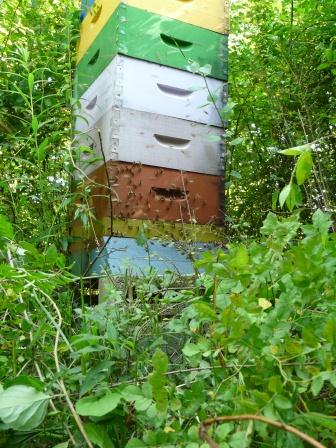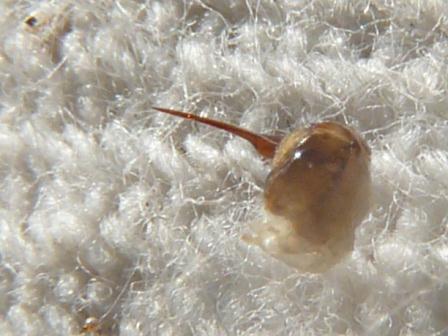I made a visit to the sisterhood at the end of the garden yesterday to see how they were doing and to add another layer to their stack of hive boxes. Both hives seem vigorous and well-stocked with bees.
 The bees in the photo below were standing at the entrance to the hive, holding their bodies up on stilt-like legs, whirring their wings. They are the hive’s air-conditioning crew, keeping a steady draft moving into the entrance, cooling the inside of the hive. When things get really hot, the ventilation crew will bring water into the hive to encourage evaporative cooling.
The bees in the photo below were standing at the entrance to the hive, holding their bodies up on stilt-like legs, whirring their wings. They are the hive’s air-conditioning crew, keeping a steady draft moving into the entrance, cooling the inside of the hive. When things get really hot, the ventilation crew will bring water into the hive to encourage evaporative cooling.
 Note below the bees with yellow baskets of pollen on their legs — this is food for the bee larvae inside.
Note below the bees with yellow baskets of pollen on their legs — this is food for the bee larvae inside.
 Before opening the hive, I give the bees a puff of smoke. This causes them to gorge on honey and, in theory, to calm down.
Before opening the hive, I give the bees a puff of smoke. This causes them to gorge on honey and, in theory, to calm down.
 A few did not get the message and tried to sting me through my gloves. One of them left her stinger embedded in the fabric (and thereby sacrificed herself for the hive — the act of stinging kills the bee). In this photo the lance-like part of the stinger is buried and we see the poison sac that continues pumping after the bee has torn herself away.
A few did not get the message and tried to sting me through my gloves. One of them left her stinger embedded in the fabric (and thereby sacrificed herself for the hive — the act of stinging kills the bee). In this photo the lance-like part of the stinger is buried and we see the poison sac that continues pumping after the bee has torn herself away.
 I pulled the stinger out (not easy — the lance is barbed) to get an idea of its length. Answer: not long enough to reach my skin.
I pulled the stinger out (not easy — the lance is barbed) to get an idea of its length. Answer: not long enough to reach my skin.
 For a view of the very tip of a bee sting, as seen under an electron microscope, see here.
For a view of the very tip of a bee sting, as seen under an electron microscope, see here.
Having given the bees the extra boxes that they need for the summer, I’ll now leave them in peace until it is time for me to make my annual bear-like robbery and collect rent.
These pictures are fantastic! I’ve been looking into the idea of photo-essays for use in the high school biology classroom and your blog is a wonderful model :-)
Hi Marie, Great idea. Using a blog like wordpress would be an easy way to get students to share — multiple authors can contribute. Hope all is well with you!
I agree, Marie, these photos are incredible! I learn something new with every post. I’ve been very concerned for the health of bees for so many years. Do you see changes in your hives population, David? And do we know how jobs are determinined in the bee colonies (who cools, who gathers pollen, etc)?
Our bees are healthy so far. We don’t feed them corn syrup and they are wild-caught, so not as inbred as commercial bees.
Jobs in the hive are determined by age — the ones you see on flowers are the oldest workers. They start out in the hive caring for babies.
Great pictures, David. When I worked in beekeeping, sometimes the stingers would reach through the protection, like if you bend or stretch and the double layer is pulled tight. Doesn’t the act of stinging release a pheromone that encourages other bees to sting?
Also, most people don’t realize that the hardest part of getting the honey is not getting stung, but how small the udders are.
Yup, I’ve been stung through a glove before. Not as bad as getting an angry bee inside the veil, though. And, yes, when they sting they do release an alarm chemical. I try to minimize all this drama by not to messing with their udders too much…
David, when I was a little girl, my father kept bees in our back yard, which happily opened onto woods. He used to come to my schools (elementary, middle, and high) to give lively illustrated talks about bees and bee-keeping (and sex, of course). I was young enough to be embarrassed, and I have to admit that I have never much liked the taste of honey. But . . . I loved having an “eccentric” father who did such things in the suburbs!
By the way, I have used class blogs in middle and high school English before, and the worked like a charm!
I can imagine that having your dad come to your school to talk about sex would be kinda embarrassing regardless of your age. Especially bee sex…the nuptial flight, multiple paternity, etc. All that stuff will shortly be illegal to discuss in TN schools, so I guess no more “birds and the bees.”
Pingback: Nested sets | Ramble